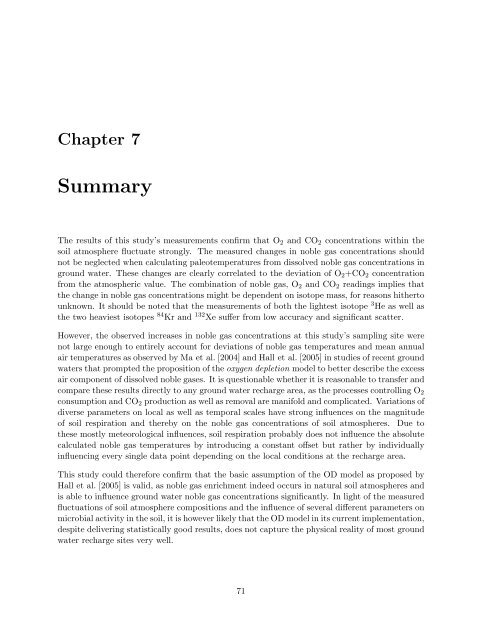Diploma thesis in Physics submitted by Florian Freundt born in ...
Diploma thesis in Physics submitted by Florian Freundt born in ...
Diploma thesis in Physics submitted by Florian Freundt born in ...
You also want an ePaper? Increase the reach of your titles
YUMPU automatically turns print PDFs into web optimized ePapers that Google loves.
Chapter 7<br />
Summary<br />
The results of this study’s measurements confirm that O2 and CO2 concentrations with<strong>in</strong> the<br />
soil atmosphere fluctuate strongly. The measured changes <strong>in</strong> noble gas concentrations should<br />
not be neglected when calculat<strong>in</strong>g paleotemperatures from dissolved noble gas concentrations <strong>in</strong><br />
ground water. These changes are clearly correlated to the deviation of O2+CO2 concentration<br />
from the atmospheric value. The comb<strong>in</strong>ation of noble gas, O2 and CO2 read<strong>in</strong>gs implies that<br />
the change <strong>in</strong> noble gas concentrations might be dependent on isotope mass, for reasons hitherto<br />
unknown. It should be noted that the measurements of both the lightest isotope 3 He as well as<br />
the two heaviest isotopes 84 Kr and 132 Xe suffer from low accuracy and significant scatter.<br />
However, the observed <strong>in</strong>creases <strong>in</strong> noble gas concentrations at this study’s sampl<strong>in</strong>g site were<br />
not large enough to entirely account for deviations of noble gas temperatures and mean annual<br />
air temperatures as observed <strong>by</strong> Ma et al. [2004] and Hall et al. [2005] <strong>in</strong> studies of recent ground<br />
waters that prompted the proposition of the oxygen depletion model to better describe the excess<br />
air component of dissolved noble gases. It is questionable whether it is reasonable to transfer and<br />
compare these results directly to any ground water recharge area, as the processes controll<strong>in</strong>g O2<br />
consumption and CO2 production as well as removal are manifold and complicated. Variations of<br />
diverse parameters on local as well as temporal scales have strong <strong>in</strong>fluences on the magnitude<br />
of soil respiration and there<strong>by</strong> on the noble gas concentrations of soil atmospheres. Due to<br />
these mostly meteorological <strong>in</strong>fluences, soil respiration probably does not <strong>in</strong>fluence the absolute<br />
calculated noble gas temperatures <strong>by</strong> <strong>in</strong>troduc<strong>in</strong>g a constant offset but rather <strong>by</strong> <strong>in</strong>dividually<br />
<strong>in</strong>fluenc<strong>in</strong>g every s<strong>in</strong>gle data po<strong>in</strong>t depend<strong>in</strong>g on the local conditions at the recharge area.<br />
This study could therefore confirm that the basic assumption of the OD model as proposed <strong>by</strong><br />
Hall et al. [2005] is valid, as noble gas enrichment <strong>in</strong>deed occurs <strong>in</strong> natural soil atmospheres and<br />
is able to <strong>in</strong>fluence ground water noble gas concentrations significantly. In light of the measured<br />
fluctuations of soil atmosphere compositions and the <strong>in</strong>fluence of several different parameters on<br />
microbial activity <strong>in</strong> the soil, it is however likely that the OD model <strong>in</strong> its current implementation,<br />
despite deliver<strong>in</strong>g statistically good results, does not capture the physical reality of most ground<br />
water recharge sites very well.<br />
71
















